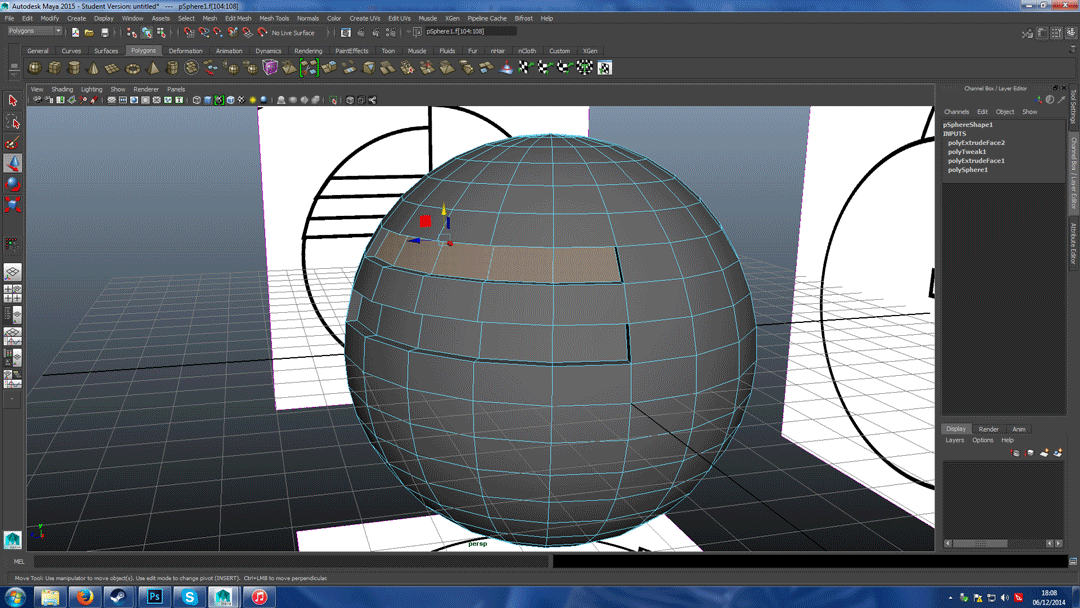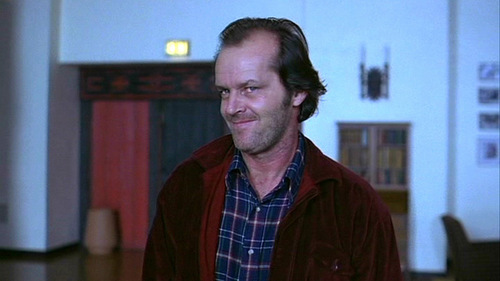 |
| Figure 1: Theatrical Poster (IMDb) |
Not on the list of movies to review but I have been talking to several people about this, some saying it's good some saying it's bad (a lot saying it's bad) so I used my free time to discover for myself.
Ridley Scott was a fan of the methods of Stanley Kubrick and there is a strong indicator he was a big fan of 2001: A Space Odyssey and it shows within the first ten minutes as we begin with a rather drawn-out flyover of mountains and canyons before we see the shadow of some spaceship that hovered above a rather athletic-looking white guy (and I mean white; his skin was chalk) with pitch-black eyes...who proceeds to kill himself with some odd substance.
The Kubrickian sense of scale does not stop there as after the ritual suicide and a quick scene in the Scottish isles we get a pan-over of a very vibrant starfield as a ship - the Prometheus - sails though space. As well as echoing 2001, Prometheus also appears to echo Scott's first A amlien film as the camera wanders the ship with the android crewmember David (Michael Fassbender). Who apparently spent his days watching old movies and learning Proto-Indo-European.
 |
| Figure 2: Seeing this a dozen times at different places was apparently enough to convince a scientist that the involved being is our creator |
I noticed straight away that this film has strong religious connotations, perhaps to the point of overbearing. David watches a memory of Elizabeth Shaw (Noomi Rapace) as her dad talks about where people go when they die (with a young Shaw being adorably curious). Shaw herself believed the aliens of the film to be humanity's creators based on the same image and the same constellation appearing in several ancient carvings and just that. There are no other indicators other than this repeating image to how these giant beings are so important to humans, which prompts derivative (and possibly understandable) laughter from the rest of the Prometheus crew when she announces her theory. Her belief in God and that the Engineers are humanity's creators are apparently what prompted Peter Weyland (Guy Vickers) to hire her for the Prometheus mission. When asked about what makes her so certain she says she has faith. She has faith in a complete hunch in my opinion. A proper scientist would have either considered all possible connotations or looked for more concrete indicators for her hypothesis.
What can often crop up in Hollywood science fiction is a lack of scientific accuracy (something that 2001 avoided by having futurist and inventor Arthur C. Clarke as a screenwriter). In this film much of the "bad science" comes from bad scientific practice. I already outlined Shaw's faith in what is a complete guess but there are plenty of stupid actions in this film that bow to the cliché of plot-induced stupidity. Shaw refuses to let one of the crew bring a weapon to an unknown alien environment, every crewmember at some point removes their helmets because the atmosphere is declared breathable (but no word on pathogen-free), crew biologist Millburn (Rafe Spall) dies because he's too mesmerised by an alien snake thing to realise it could kill him (and it does, no surprise), quarantine apparently involves spraying something with CO2 (I think) until it is considered "clean" and the personal quarters of Meredith Vickers (Charlize Theron, a woman) contains a robotic surgery bed that can only autonomously work on male patients.
 |
| Figure 3: Pretty sure something that shares our DNA to the last gene can't tear off an android's head like it was the lid of a jam-jar. |
There is also more typical bad science going on. It is revealed halfway though that the Engineer DNA is a 100% match to human DNA. 100% could have been a buzzword for "practically identical" were it not for Shaw saying it as if she is reading it off a screen - which it was. The Engineers however are 10ft tall chalk-white ebony-eyed supermen that can yank an Android's head from it's spine (in Alien, Ash's head was dislodged when Parker took a wrench to it but it was still connected to his body). That armour on the right also looks vaguely like it's part of his body; either he was genetically modified (which throws a wrench in the "100% match" idea as the sample came from an identical type of guy) or it's more Giger-inspired biomechanics. This super strength is also demonstrated by smacking several men across the rather large room. If these engineers were a 100% genetic match to us they could have perhaps been a teensy bit more human.
As far as films go it was decent if a bit ambitious; a B-movie trying to be an epic saga that might be a bit too heavy-handed when it comes to its religious messages. Some transhumanists might find Shaw's answer of "you are a robot, you wouldn't understand" to David not quite understanding why she wants to meet the Engineers despite them wanting to destroy her to be offensive, made worse in that David spent the movie in an experience reminiscent of Pinnochio. I wouldn't rate this highly but it's not unwatchable if what you are after is cinematic spectacle and special effects. If you are after this century's 2001 however, Interstellar might be a better option.
Image Reference
- Figure 1: IMDb, unknown; [Theatrical poster]; available at http://ia.media-imdb.com/images/M/MV5BMTY3NzIyNTA2NV5BMl5BanBnXkFtZTcwNzE2NjI4Nw@@._V1_SX214_AL_.jpg
- Figure 2: Raiin, J., 2014; [Seeing this a dozen times at different places was apparently enough to convince a scientist that the involved being is our creator]; available at https://blogger.googleusercontent.com/img/b/R29vZ2xl/AVvXsEhve160wKd3isXt_LcI0pmjVPcG6MxgldMYdLyCeQqzQi1jrWLH8JiyahjIrugv0RfRNFO7EaTJ_c-6Oz0sLmYiRrDk6Jlti5lYEL-4mEgaxyFOrbTOOy_1x-BYDYGHfE2bHkE_G4Ew5rwi/s1600/promemap.png
- Figure 3: "Pretty--Kittie", 2013; [Pretty sure something that shares our DNA to the last gene can't tear off an android's head like it was the lid of a jam-jar.]; available at http://pretty--kittie.deviantart.com/art/Prometheus-Engineer-407316085







































Hi Mark,
That's one sensual, luxuriant city you describe - I was quite swept away by your lavish descriptions of this 'petal city'! I enjoyed your travelogue very much! You've given yourself a richness of detail there in terms of inspiring your next thumbnails - and it appears as if you're moving towards those dominant towers as being among your 'key assets' in terms of working in Maya. The only thing I'd say is be sure to go back to the works of Treacy as a touchstone even as you've identified 'petals' as a preoccupation of the designer, and as you move towards developing your key assets. Don't let this world of 'flower-like' forms as inspired by Treacy become a world of architectural flowers; look again at the essential organic shapes favoured by Treacy and ensure you maintain that same level of 'abstraction'; for example, the idea of having actual globe artichokes as architectural elements is too literal; and the idea of the city 'being' a lotus flower - is also too literal; for example, if you were to look at the Sidney Opera House, it's suggestive of lots of organic elements, but is not quite any of them either:
http://upload.wikimedia.org/wikipedia/commons/4/40/Sydney_Opera_House_Sails.jpg
So, just don't take your eye of Treacy as you seek to take your city to the next level of refinement.
I can understand where I may have been a little too literal as some of Treacy's hats do appear like that and I think I became a little too preoccupied with mimicking these designs.
http://i.telegraph.co.uk/multimedia/archive/02871/treacy1_2871104b.jpg
https://blogger.googleusercontent.com/img/b/R29vZ2xl/AVvXsEjwWDb9ipb9uDGYOM3MosVAorWXu-3dII4JFDM652w9jK62Yh1X78xfTpGsP6NhEzUDXdskyuvtnyJdKMjMWT0f5feboTBqjlMOz9bRx9rsZQPmO-tNQMae1stZ0DM2_tP2hxqM_gEK2-w/s1600/P1090730d.jpg
But true they are not his only forms, he is also known for abstract looping and folding designs as well as the usage of feathers. One idea I had earlier on was to take the shape and arrangement of the lotus petals but only as an outlining "sliced and laid out orange wedges" kind of shape. Some of his designs do appear as curved leaves, but they are also un-leaflike In terms of colour and pattern.
http://i.dailymail.co.uk/i/pix/2011/05/04/article-1383648-0BD71EFB00000578-934_306x423.jpg
I will look into making my buildings organic, but abstract. Part of the reason was perhaps I did not want to wander too far into the designs of Zaha Hadid who uses plenty of organic shapes but not in the same way Treacy does.
http://danadecals.com/blog/wp-content/uploads/2012/04/214.jpg
simple, strong, organic, essentialised... this is what you need - not complex pencil drawings, but punchy forms; why not take Treacy's hats and turn them into an inventory of silhouettes for recombining?
Time to change up your method!
With the latter interpretation, I think such a combination may work as we both enjoy organic and nature-inspired styles and shapes. The brief felt quite brief on our intended relationship with our designers.
At the moment, numbers 4,5 and 8 appeal to me the most....
Just a thought, could you post your silhouettes of the hats that you are using to construct these cityscapes, if you haven't done so already? (I have had a look through, but I can't see them...) I think it would be useful for your viewer to see what the shapes are derived from :)
I'll see what I can do about posting my silhouette templates. I have a collection of the templates I used on my home PC so when I can I will see about pasting them on to a contact sheet.
Though..
As Senbon Zakura is a Japanese term (I'm assuming from that one Hatsune Miku song...) would it be fitting to use it as a name for your city? Philip Treacy does do a lot with flowers and so cherry blossoms would be justified in that sense.. however he is Irish, not Japanese. That and you talked about your city perhaps being in a Chinese Valley. That could also be very contradicting. The same Kanji is used for "One Thousand Cherry Blossoms" in Chinese and Japanese but it is a different pronunciation. There's a clash of culture.
Curious about your reasoning is all, sorry if this sounds a little rude, I don't mean to be! ^^